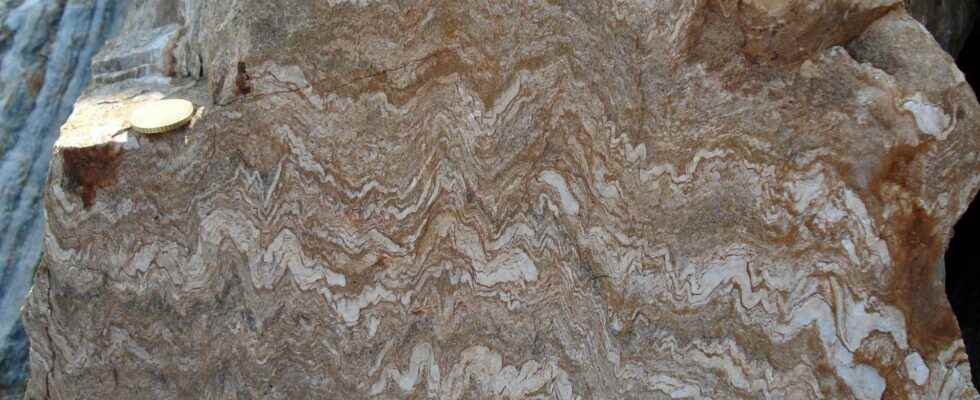The study of metamorphic rocks is essential to understanding the tectonic history of a region. We are talking about metamorphism when a rock, whatever it is, undergoes a transformation linked to an increase in pressure and temperature. The study of these modifications therefore makes it possible to retrace the path followed within the Earth’s crust.
The mineralogical composition of a rock testifies to the pressure and temperature conditions experienced
From the beginning of the XXand century, scientists discovered that the intensity of metamorphism could be correlated with the appearance of certain mineralssuch as chlorite, biotite, staurolite, kyanite and sillimanite. These minerals, which are part of the aluminous series, are then used as marker minerals to define the degree of metamorphism that the rock has undergone. In the field, it becomes possible to quickly establish, from the observation of the mineralogical composition, different metamorphic zones. Although useful, this method is not precise enough to determine exactly the pressure and temperature conditions experienced by the rock.
In 1915 the geologist finnish Eskola proposes the concept of facies metamorphic. He defines it as follows: in any metamorphic rock that has reached a chemical equilibrium via metamorphism under conditions of constant temperature and pressure, the composition of minerals is controlled solely by the chemical composition of the rock “. In other words, the mineralogical composition of a metamorphic rock makes it possible to go back to the conditions of pressure and temperature undergone, according to the composition of the protolith (the original rock).
The different metamorphic facies defined by Eskola
This classification is used universally today. It is originally based on the basic series (gabbros) and no longer aluminous. We thus mainly distinguish:
- the facies of zeoliteswhich marks the first degree of metamorphism, after the process of diagenesis. The temperature range is less than 300°C, the low pressure;
- the prehnite-pumpellyite facies: temperature of 350 to 400°C, moderate pressure;
- the facies of corneal, which extends over a wide temperature range (up to more than 800 °C) but for low pressures. This is the typical facies of contact metamorphism. Typical minerals are: orthoclase, plagioclase, andalusite, cordierite, biotite, hypersthene-enstatite, diopside, wollastonite, grossular-andradite, olivine;
- the facies of shales green: low temperature, medium pressure. Typical minerals are: albite, sericite, chlorite, talc, serpentineepidote, calcitedolomite;
- the blue shale facies (or shale facies with glaucophane), characteristic of low temperature but high pressure metamorphism. One finds rocks of this facies in particular in the inner areas of mountain ranges or in subduction zones;
- the facies of amphibolites, characteristic of metamorphism at high pressure and temperature. These conditions are close to those of the merger. Typical minerals are: amphiboles, microcline, plagioclase, muscovite, andalusite, almandine, anthophyllite, cummingtonite, diopside, wollastonite, grossular-andradite;
- the facies of granulitesmarked by very high temperatures and very high pressures, conditions typical of the base of the continental crust;
- the eclogite facies, characteristic of a range of high temperature and enormous pressure. This facies is associated with a dehydration progressive rocks. These conditions mark in particular the transformation of gabbros and basalts in rocks rich in pyroxenes and garnets;
- the sanidinite facies which is characterized by very high temperatures but very low pressure (hardly more than the atmospheric pressure). This facies is characteristic of the episodes of “cooking” of a rock in contact with a wash for example. Typical minerals are: sanidine, plagioclase, sillimanite, cordierite, clinoenstatite-diopside, wollastonite, olivine.
Rocks can change from one facies to another depending on changing conditions
Be careful, the facies is there to understand in which temperature-pressure range a rock has changed. Even if the name of the facies corresponds to the name of certain metamorphic rocks by which the facies have been defined, this does not mean that all the rocks entering a facies have its name. For example, under 6 kbar and 550°C, a basalt becomes an amphibolite (rich in amphiboles), but a granite will become a gneiss with two micas (rich in plagioclases, quartz, feldspar, but without amphiboles). Both rocks still belong to the amphibolite facies.
Rocks can change from one facies to another, depending on the joint evolution of pressure and temperature. Thus, in areas of subductionthe rocks gradually change from greenschist facies to blueschist and then to eclogite.
You will also be interested
Interested in what you just read?
